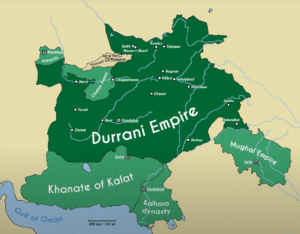The Rise and Fall of the Sikh Empire: Part 3 – Persian & Afghan Invasions

“The sack of Delhi by Nadir Shah and the massacre of its citizens left a deep impression on the Sikhs, confirming their belief that the Mughals were no longer capable of defending Hindustan. The weakening of central authority provided the Khalsa with a rare opportunity to assert itself.”
History of Sikhs Vol. 1 & Vol. 2
Khushwant Singh
The Punjab region in the 18th century became one of the most fiercely contested battlegrounds in South Asia. Following the fall of the Mughal Empire’s centralized control, Punjab found itself at the crossroads of multiple invading forces, with the Sikhs, Persians, Afghans, and Marathas all vying for dominance. Two major figures, Nader Shah Afshar of Persia and Ahmed Shah Abdali of Afghanistan, played critical roles in shaping the region’s future. However, despite these formidable external threats, the Sikhs not only survived but emerged as the ultimate rulers of Punjab. Their resilience, adaptability, and mastery of guerrilla warfare allowed them to outmaneuver their far more powerful adversaries and lay the foundation for the eventual establishment of the Sikh Empire.

Nader Shah’s Invasion and the Sikh Resistance
The fragile peace in Punjab was shattered in 1739 when Nader Shah Afshar, the Persian warlord and founder of the Afsharid Dynasty, launched his invasion of the Indian subcontinent. By this time, Nader Shah had already consolidated a mighty empire stretching from Georgia in the west to Afghanistan in the east, and his ambitions now turned toward India. Sensing the weakening Mughal grip on Punjab, he sought to expand his empire at the expense of the crumbling Mughal regime.
With a highly disciplined and battle-hardened army, Nader Shah swept through northern Punjab with devastating force. The Mughal governor of Punjab, Zakariya Khan, aware of the Mughals’ declining military strength, made the pragmatic decision to switch allegiances. Instead of resisting Nader Shah, he chose to submit to Persian authority in order to preserve his own power. However, while Zakariya Khan aligned himself with the Persians, the Sikh Khalsa refused to accept Persian domination. Rather than engage in open battle against the vastly superior Persian forces, the Dal Khalsa withdrew into their mountain hideouts, biding their time for the right opportunity to strike.
After confirming the submission of Punjab’s governor, Nader Shah marched toward the Mughal capital of Delhi, dealing a catastrophic blow to the already declining Mughal Empire. His army plundered Delhi, indiscriminately massacring its population and looting its wealth. After sacking the city, Nader Shah began his return journey, traveling back through Punjab, heavily laden with loot, prisoners, and slaves.
It was during this return march that the Sikhs launched a daring campaign against Nader Shah’s army. Utilizing their superior knowledge of the terrain, the Sikhs descended from their mountain strongholds and conducted relentless hit-and-run attacks on the Persian baggage train. They plundered the Persian army’s supply lines, freeing thousands of Indian slaves in the process and reclaiming some of the stolen wealth. This not only showcased Sikh military prowess but also reinforced their reputation as defenders of the oppressed.

The Rise of the Durrani Empire and the Afghan Invasions
In 1747, Nader Shah was assassinated, leading to the disintegration of his empire. The power vacuum in eastern Persia and Afghanistan led to the rise of Ahmed Shah Abdali, also known as Ahmed Shah Durrani, who quickly established the Durrani Empire. Abdali, an ambitious military leader and former commander under Nader Shah, sought to expand his dominion into Punjab and northern India, which he saw as his rightful territory.
Between 1747 and 1769, Ahmed Shah Abdali launched nine invasions into India, each time targeting Punjab as a strategic gateway to the Mughal heartland. Unlike Nader Shah, who sought plunder, Abdali’s goal was to establish long-term control over Punjab and integrate it into his empire. He managed to establish overlordship over much of Punjab, at times occupying Lahore, the region’s most important city.
However, Sikh resistance to Abdali’s rule proved relentless. Shortly after Abdali’s first invasion, the Sikhs convened in Amritsar for their annual Sarbat Khalsa, the grand assembly of Sikh leaders. Realizing the enormity of the Afghan threat, they restructured the Khalsa Army to better counter Abdali’s forces. The number of Jatha regiments within the Sikh military swelled, necessitating a more structured command. Under the Sarbat Khalsa’s decree, the Sikh forces were consolidated into twelve military divisions known as Misls.
Each Misl was led by a Misldar, or chieftain, and operated semi-autonomously, allowing for greater flexibility in battle. However, they all acknowledged the supreme command of Jassa Singh Ahluwalia, who had been elected as the High Commander of the Dal Khalsa, succeeding the aging Nawab Kapur Singh.
Punjab: The Battleground of Empires
Throughout the mid-18th century, Punjab became one of the most ruthlessly contested territories in Asia. The region saw continuous conflict between the Afghans, the declining Mughals, and the expansionist Marathas. Amidst this turmoil, the Sikh Misls adopted guerrilla tactics that allowed them to survive and eventually thrive.
Rather than engage in pitched battles against numerically superior Afghan forces, the Dal Khalsa strategically avoided direct confrontations. Instead, they allowed the Afghans, Mughals, and Marathas to exhaust themselves fighting one another. Once their adversaries were weakened, the Sikhs would strike, targeting supply lines, baggage trains, and isolated military detachments.
The Sikh warriors were expert cavalrymen, often attacking large columns of enemy troops, discharging their muskets at close range, and swiftly retreating before the enemy could respond. Their superior mobility made it nearly impossible for Abdali’s forces to pin them down. As Ahmed Shah Abdali’s repeated invasions ravaged Punjab, the Sikhs only grew stronger, more organized, and more defiant.
The Collapse of Mughal and Afghan Control & the Sikh Ascendancy
By the 1760s, the relentless invasions and infighting among the major powers had left Punjab in ruins, but the Sikh Misldars had slowly filled the power vacuum left behind by the Afghan and Mughal decline. What began as mere guerrilla raids evolved into the Sikhs establishing political and territorial control over vast portions of Punjab.
Sikh leaders began extracting tribute from local villages in exchange for protection, asserting their influence over the region. By the end of the Afghan invasions, the Misls had effectively become independent states, governing large swaths of Punjab’s river valleys. The city of Lahore, once a stronghold of Mughal and Afghan rule, now fell into the hands of the Sikhs.
Although each Misl operated autonomously, they continued to recognize the overarching authority of Jassa Singh Ahluwalia and the Dal Khalsa. This confederation of independent yet allied Sikh states became known as the Sikh Confederacy—a precursor to the eventual unification of Punjab under Maharaja Ranjit Singh.
The Triumph of the Sikhs
The Persian and Afghan invasions of Punjab left a devastating impact on the region, yet they also created the conditions for Sikh ascendancy. By outlasting and outmaneuvering the Mughals, Persians, and Afghans, the Sikhs emerged as the dominant power in Punjab by the late 18th century.
Through patience, strategic warfare, and sheer resilience, the Sikhs transformed from a persecuted warrior brotherhood into the de facto rulers of Punjab. Their ability to adapt to new threats, strike decisively, and unite under a shared vision of sovereignty allowed them to eventually forge the Sikh Empire, which would stand as one of the most powerful states in Indian history.
The invasions of Nader Shah and Ahmed Shah Abdali may have sought to subjugate Punjab, but in the end, they only strengthened the resolve of the Sikh people, setting them on a path to independence, strength, and enduring legacy.
Link to blogs in this series:
- The Rise and Fall of the Sikh Empire: Part 1 – The Rise and Fall of Banda Bahadur
- The Rise and Fall of the Sikh Empire: Part 2 – Sikh Persecution
- The Rise and Fall of the Sikh Empire: Part 3 – Persian & Afghan Invasions
- The Rise and Fall of the Sikh Empire: Part 4 – The Rise of the Sikh Empire
- The Rise and Fall of the Sikh Empire: Part 5 – The Fall of Sikh Empire
References:
- The Sikhs by Khushwant Singh
- A History of the Sikhs: Volume 1: 1469by1838 by Khushwant Singh
- A History of the Sikhs: Volume 2: 1839by2004 by Khushwant Singh
- The Sikhs of the Punjab by J.S. Grewal
- The Fall of the Kingdom of Punjab by Khushwant Singh
- The Sikh Gurus by Dhillon Harish
- The Sikh World by Pashaura Singh & Arvind Pal Singh Mandair
👁️ 307 views

